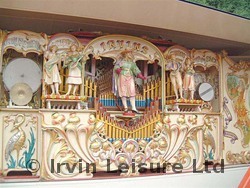Fairground Organ is Bridge from Past to New Carousel

 At the same time as the brand new Irvin Carousel takes its bow at George Irvin’s Fair, a craftsman relates his work in renovating a part of the family and fairground history.
At the same time as the brand new Irvin Carousel takes its bow at George Irvin’s Fair, a craftsman relates his work in renovating a part of the family and fairground history.
At the same time that the new superb Irvin Family Carousel starts a new chapter in the story of this showland family, craftsman and enthusiast John Page has told how he has recently renovated the 89 key fairground organ that proudly entertained riders on the last Irvin’s Carousel from 1914 right up to 2002. If you log onto his website, www.johnpage.co.uk/organs, then click on restoration, you can find the full story, with beautiful and fascinating photographs, of John’s work, but here we summarise part of it here for your interest. But do not miss the chance to read this incredible story in full, because you will learn that the great skills of the original manufacturer are at least matched, and possibly surpassed, by Mr Page and his associates work today.
John relates the history of this organ, first purchased by the Irvin family in 1914 but originally built in the Marenghi workshops in 1909 and operating in fairgrounds since that date. For much of this time George Irvin the First ran the Carousel, organ and all, then from 1970 by his son Benny, sadly no longer with us today. He reports how he first came across the organ when Irvin’s Carousel was in Covent Garden in 1982, but found that the sound was off key and appalling. Well, frankly the organ was already 73 years old by then, so bound to be a little tired, but John visited Benny Irvin’s yard on many occasions, including in snow and sleet, and had it back up and playing beautifully by the following Easter for the annual Irvin visit to Hampton Court Palace. To be honest, your writer feels that when he is 73 should he find himself singing outside the National Opera House in Covent Garden he too would sound pretty bad, and it will take a bit more than touching up to get him sounding tuneful again! It would take more than that already.
Mr Page describes the operation of the organ, which plays using cardboard book music running through a key frame and mounted on the end of the organ, with 89 keys emulating Trombone, melody, piccolo, drums, cymbal and mute. A fantastic and complex structure, designed and built with great skill and delicacy, and John includes on his site some pictures of this intrument in action in its prime.
John then goes on to tell how, after it left the Irvin family for the final time, it came to him to repair, and that this time he needed to do much more than simple renovation. He undertook a full and complete reconstruction; lovingly and skillfully repairing piece by piece the entire item. He had estimated that the work would take six months to complete, but found that his estimate of time was similar to that of the construction team at Wembley Stadium, so the six months stretched as he carefully, with expert assistance of other craftspersons and enthusiasts, brought this wonderful link to the Edwardian age back to its best, and now you will find it in operation at such major festivals as the Great Dorset Steam Fair and the Bedford Steam Rally.
For those of us who find the task of pressing play on a CD player difficult to achieve, the thought of the installation of a Saxophone Chest, a Violin Chest, Reed Pipes, and a Glockenspiel is, if not inspiring, then terrifying! Therefore let no one be in any doubt that wonderful though the latest Irvin Carousel may be, and it certainly is that; no matter how much pleasure it will bring to those who ride it, which it certainly will; and no matter how great the skill of the constructors of this latest work of fairground art, which is much to be admired; it does not compare to those who built the first Irvin Carousel, or those Marenghi staff of 100 years ago who constructed the organ. Also, it perhaps does not compare to John Page and his team from the 21st century who help us bridge the years by preserving and maintaining this historic instrument.
It is a sad thought that over the life time of this organ, many who rode the horses and listened to the music are no longer with us. It is heartbreaking to remember that this organ was purchased just before the slaughter of the First World War, when so many fairground patrons were called into the services to die so young. But perhaps it is a fitting tribute to them, and to the generations of Irvins who operated the ride and who have also passed on after a lifetime of bringing pleasure to the public, that this bridge is still there and will be enjoyed by generations still unborm. As you listen to the great fairground tunes playing away, you can hear the laughter of those who rode before, and perhaps somewhere they still get pleasure from this. For as long as there are people like John Page and his team who will enable this to happen, the music that made them happy will live on.
Now visit www.johnpage.co.uk and marvel at the detail of his work and enjoy the craftsmanship of bygone times, still around today.